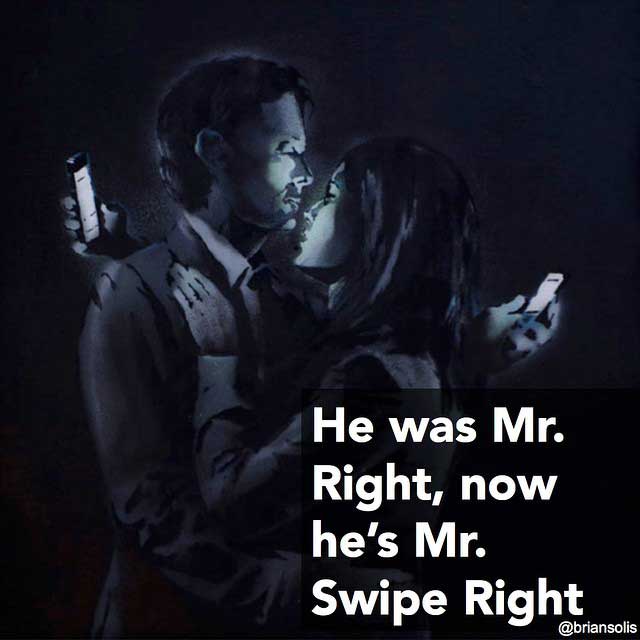If you’re sitting in a room with two of your closest friends, chances are they’re dating, met online and you’re the sad single sack who hasn’t tried Tinder yet. Just kidding! Don’t be sad. Maybe they met on Happn, Grindr, Hinge, Hitch, Coffee Meets Bagel, Match.com, HowAboutWe, Down, PlentyOfFish, OkCupid or — if you’re lucky enough to have famous creative friends — Raya.
Actually, that’s all a bit of a stretch, but data put out by Berkeley’s School of Information says that two-thirds of Americans have at least tried online dating. Are you the odd man/woman out? The Proceedings of the National Academy of Sciences also tells us that one-third of American married couples met online. (But be wary of that one: eHarmony may or may not have funded it.) Other research from Stanford University and Michigan State University found that couples who meet online are more likely to break up. So if you’re having mixed feelings about it, then maybe you should.
Services like eHarmony and Match seemed aimed at finding life partners, whereas sites and apps like PlentyOfFish, OkCupid and Tinder have a reputation for people looking to hook up. Casually dating a hook-up buddy still equals “relationship,” but that doesn’t always bode well for long-term commitments. Either way: If you’re looking for casual sex, you can find it on your phone or computer. If you’re looking for a partner who shares the same values with you (according to a computerized matching system), you can find that too. Both are totally okay for your to pursue nowadays.
The Pew Research Center has statistics proving that the stigma that once surrounded online dating has largely dissipated in a market flooded by these dating websites and apps. It’s a $1.75 billion industry.
But this destigmatization coincides with a shift in dating trends more broadly speaking. In-person flirting will never die, but anecdotally, it seems like the traditional progression toward full-on dating has changed greatly. “Dates” don’t really happen as much, not like they used to. Labels have more to do with whether he relationship is Facebook-official. And when’s the last time you or someone you know actually asked someone out or was asked out in person?
I remember being puzzled in college as I tried to legitimately date girls who quickly dismissed my awkward attempts at chivalry and propriety. To ask someone out on a “date” has eroded into an oddity. You bring flowers on a date? Clingy. Freakish. To “hang out” or even “chill” is the norm now. You spend time in a group, maybe one on one eventually. Then if something sparks between you, it might happen again. Before you know it, you’re dressed up as a Spartan Warrior at a Halloween party and she’s the Kool-Aid Man, and when someone asks you if you’re official, you both look at each other, sort of shrug and say, “Of course!”
Or maybe you never label it. Maybe you’re using an app like Tinder that literally gamifies your romantic experiences. There’s certainly no shame in using an online resource to meet people, but what does it say about our culture when it slides toward being the norm rather than an oddity? The digitization of everything these days is positively overwhelming. Having more options, whether we’re talking about television and film on streaming services, or Tinder in our personal lives, means that the very act of making a choice is desensitized and made more meaningless.
Binge-watching a show is the psychological equivalent of a one-night stand; you might have a vague, fond memory, but in three months time, your brain will grasp at remembering a name. In Tinder, you slide through options with a flick of the wrist, and judging a person based on one picture is as simple as swiping to either side.
Analysts presume that Tinder has 80 million users globally with around 1.8 billion swipes daily. Hey, I’ll admit it, I “played” it once on a single friend’s phone when I was tipsy (because it really is just a game when you think about it). But when you play it like a game, are you doing it right? Or are you degrading both yourself and the people you engage with? It’s hard not to think of it as a game, especially when humor websites post viral articles almost weekly featuring hilariously awkward Tinder disasters or comical new pick-up techniques. This is all a joke, right?
Of the people who use online dating services, 81% lie about their height, weight or age. For Tinder, the pictures that it aggregates for your profile are pulled directly from your Facebook page, a collection of all your most carefully curated photographs. Is that, in and of itself, ever an accurate portrayal of who we really are? Does any of this really matter for an app that’s been publicly accused of increasing the spread of STDs?
Perhaps I just need more “chill” — no, not the verbal, euphemistic form used in “Netflix and Chill” (a ubiquitous term whose appearance in OkCupid profiles rose 5,357% in 2015) — but chill, the adjectival state of being relaxed. Passion and too much singular attention is often seen as obsessiveness, particularly in the casual dating market purported by Tinder. Modern dating is now all about the saturation of choices, the power to condemn anyone we want to a left swipe and the struggle to connect with our thumbs and phones, rather than our hearts and minds.
What is a modern romantic to do?
More Posts by The Author:
Student Food Truck Program: Riding food trucks to culinary awareness
That Nashville Shine: Moonshine Alley serves a little bit of country in Providence
Welcome to Bucktown, Population: Delicious
Conscious Financial Coupling
Pokemon Go Goes Faster than Any of Us Thought



